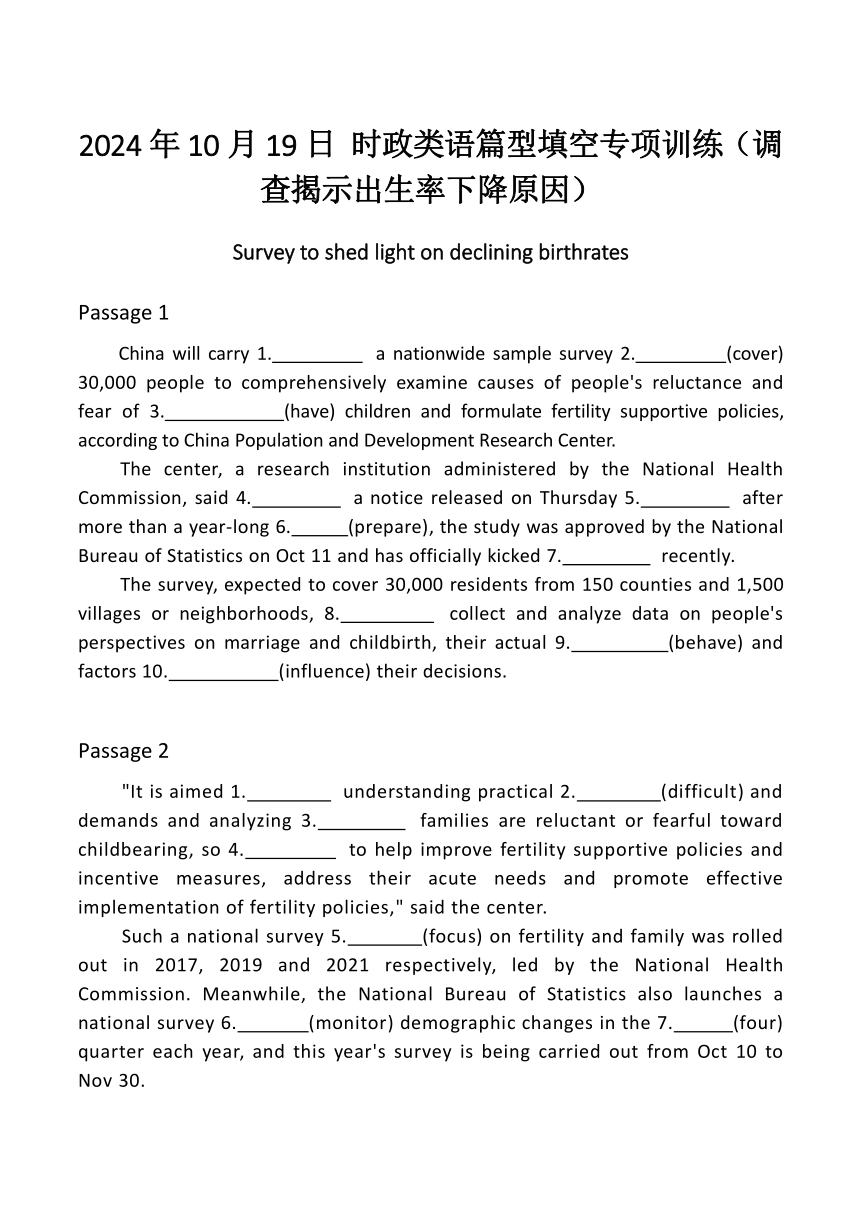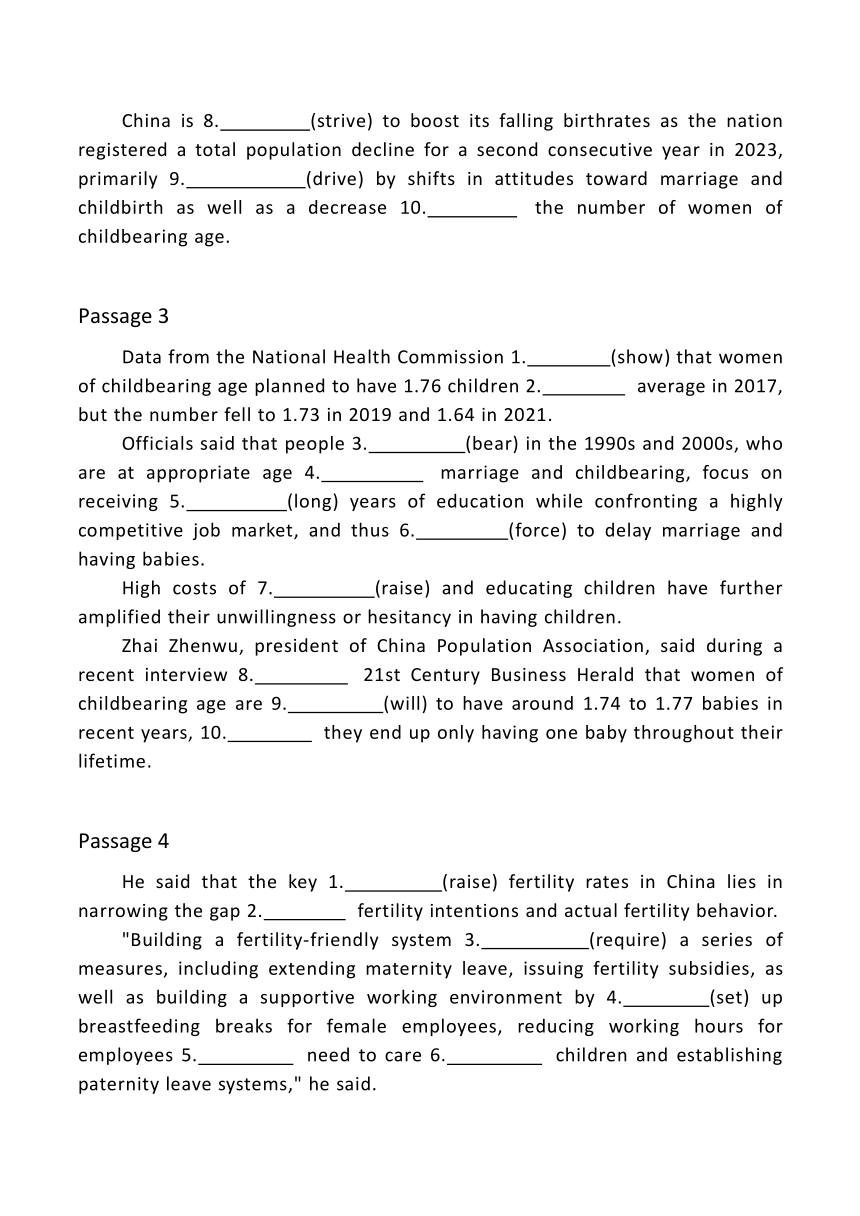2024年10月19日 时政类语篇型填空专项训练(调查揭示出生率下降原因)(4篇,含答案和译文) -2025届高三英语复习专项
文档属性
| 名称 | 2024年10月19日 时政类语篇型填空专项训练(调查揭示出生率下降原因)(4篇,含答案和译文) -2025届高三英语复习专项 |  | |
| 格式 | docx | ||
| 文件大小 | 27.9KB | ||
| 资源类型 | 教案 | ||
| 版本资源 | 人教版(2019) | ||
| 科目 | 英语 | ||
| 更新时间 | 2025-01-16 22:31:54 | ||
图片预览


文档简介
2024年10月19日 时政类语篇型填空专项训练(调查揭示出生率下降原因)
Survey to shed light on declining birthrates
Passage 1
China will carry 1. a nationwide sample survey 2. (cover) 30,000 people to comprehensively examine causes of people's reluctance and fear of 3. (have) children and formulate fertility supportive policies, according to China Population and Development Research Center.
The center, a research institution administered by the National Health Commission, said 4. a notice released on Thursday 5. after more than a year-long 6. (prepare), the study was approved by the National Bureau of Statistics on Oct 11 and has officially kicked 7. recently.
The survey, expected to cover 30,000 residents from 150 counties and 1,500 villages or neighborhoods, 8. collect and analyze data on people's perspectives on marriage and childbirth, their actual 9. (behave) and factors 10. (influence) their decisions.
Passage 2
"It is aimed 1. understanding practical 2. (difficult) and demands and analyzing 3. families are reluctant or fearful toward childbearing, so 4. to help improve fertility supportive policies and incentive measures, address their acute needs and promote effective implementation of fertility policies," said the center.
Such a national survey 5. (focus) on fertility and family was rolled out in 2017, 2019 and 2021 respectively, led by the National Health Commission. Meanwhile, the National Bureau of Statistics also launches a national survey 6. (monitor) demographic changes in the 7. (four) quarter each year, and this year's survey is being carried out from Oct 10 to Nov 30.
China is 8. (strive) to boost its falling birthrates as the nation registered a total population decline for a second consecutive year in 2023, primarily 9. (drive) by shifts in attitudes toward marriage and childbirth as well as a decrease 10. the number of women of childbearing age.
Passage 3
Data from the National Health Commission 1. (show) that women of childbearing age planned to have 1.76 children 2. average in 2017, but the number fell to 1.73 in 2019 and 1.64 in 2021.
Officials said that people 3. (bear) in the 1990s and 2000s, who are at appropriate age 4. marriage and childbearing, focus on receiving 5. (long) years of education while confronting a highly competitive job market, and thus 6. (force) to delay marriage and having babies.
High costs of 7. (raise) and educating children have further amplified their unwillingness or hesitancy in having children.
Zhai Zhenwu, president of China Population Association, said during a recent interview 8. 21st Century Business Herald that women of childbearing age are 9. (will) to have around 1.74 to 1.77 babies in recent years, 10. they end up only having one baby throughout their lifetime.
Passage 4
He said that the key 1. (raise) fertility rates in China lies in narrowing the gap 2. fertility intentions and actual fertility behavior.
"Building a fertility-friendly system 3. (require) a series of measures, including extending maternity leave, issuing fertility subsidies, as well as building a supportive working environment by 4. (set) up breastfeeding breaks for female employees, reducing working hours for employees 5. need to care 6. children and establishing paternity leave systems," he said.
Yu Xuejun, vice-minister of the commission, said during a news conference last month 7. health authorities will dedicate greater efforts into ramping up provision of affordable nursery care services to reduce (finance) burden of families, while advocate getting (marry) and having children at appropriate ages and sharing parenting (responsible) between couples.
参考答案
参考答案1
1.out 2.covering 3.having 4.in 5.that
6.preparation 7.off 8.will 9.behaviors 10.influencing
参考译文1
中国人口与发展研究中心表示,中国将在全国范围内开展一项覆盖3万人的抽样调查,全面调查人们不愿和害怕生育的原因,并制定生育支持政策。
该中心是由国家卫生健康委员会管理的一个研究机构,在周四发布的一份通知中表示,经过一年多的准备,该研究于10月11日获得国家统计局的批准,并于近日正式启动。
这项调查预计将覆盖来自150个县和1500个村庄或社区的3万名居民,将收集和分析人们对婚姻和生育的看法、他们的实际行为以及影响他们决定的因素。
参考答案2
1.at 2.difficulties 3.why 4.as 5.focusing
6.to monitor 7.fourth 8.striving 9.driven 10.in
参考译文2
该中心表示:“它旨在了解实际困难和需求,分析家庭不愿或害怕生育的原因,从而帮助改善生育支持政策和激励措施,解决他们的迫切需求,促进生育政策的有效实施。”
由国家卫生健康委员会牵头,于2017年、2019年和2021年分别开展了以生育和家庭为重点的全国性调查。与此同时,国家统计局也会在每年第四季度开展一项全国人口调查,以监测人口变化,今年的调查将于10月10日至11月30日进行。
随着2023年中国总人口连续第二年下降,中国正在努力提高其不断下降的出生率,这主要是由于对婚姻和生育态度的转变以及育龄妇女数量的减少。
参考答案3
1.shows 2.on 3.born 4.for 5.longer
6.forced 7.raising 8.with 9.willing 10.but
参考译文3
国家卫生健康委员会的数据显示,2017年育龄妇女平均计划生育1.76个孩子,但2019年降至1.73个,2021年降至1.64个。
官员们表示,90后和00后适龄结婚和生育,面对激烈的就业市场竞争,他们专注于接受更长的教育,因此被迫推迟结婚和生育。
养育和教育孩子的高成本进一步放大了他们不愿意或犹豫要孩子。
中国人口协会会长翟振武最近在接受21世纪经济报道记者采访时表示,近年来育龄妇女愿意生1.74到1.77个孩子,但她们最终一生只生一个孩子。
参考答案4
1.to raising 2.between 3.requires 4.setting 5.who
6.for 7.that 8.financial 9.married 10.responsibilities
参考译文4
他说,提高中国生育率的关键在于缩小生育意愿和实际生育行为之间的差距。
他说:“建立一个有利于生育的制度需要采取一系列措施,包括延长产假、发放生育补贴,以及通过为女员工设立哺乳休息时间、减少需要照顾孩子的员工的工作时间、建立陪产假制度来营造一个支持性的工作环境。”
卫计委副部长于学军在上个月的新闻发布会上表示,卫生部门将更加努力地提供负担得起的托儿所服务,以减轻家庭的经济负担,同时提倡在适当的年龄结婚生子,夫妻之间分担育儿责任。
Survey to shed light on declining birthrates
Passage 1
China will carry 1. a nationwide sample survey 2. (cover) 30,000 people to comprehensively examine causes of people's reluctance and fear of 3. (have) children and formulate fertility supportive policies, according to China Population and Development Research Center.
The center, a research institution administered by the National Health Commission, said 4. a notice released on Thursday 5. after more than a year-long 6. (prepare), the study was approved by the National Bureau of Statistics on Oct 11 and has officially kicked 7. recently.
The survey, expected to cover 30,000 residents from 150 counties and 1,500 villages or neighborhoods, 8. collect and analyze data on people's perspectives on marriage and childbirth, their actual 9. (behave) and factors 10. (influence) their decisions.
Passage 2
"It is aimed 1. understanding practical 2. (difficult) and demands and analyzing 3. families are reluctant or fearful toward childbearing, so 4. to help improve fertility supportive policies and incentive measures, address their acute needs and promote effective implementation of fertility policies," said the center.
Such a national survey 5. (focus) on fertility and family was rolled out in 2017, 2019 and 2021 respectively, led by the National Health Commission. Meanwhile, the National Bureau of Statistics also launches a national survey 6. (monitor) demographic changes in the 7. (four) quarter each year, and this year's survey is being carried out from Oct 10 to Nov 30.
China is 8. (strive) to boost its falling birthrates as the nation registered a total population decline for a second consecutive year in 2023, primarily 9. (drive) by shifts in attitudes toward marriage and childbirth as well as a decrease 10. the number of women of childbearing age.
Passage 3
Data from the National Health Commission 1. (show) that women of childbearing age planned to have 1.76 children 2. average in 2017, but the number fell to 1.73 in 2019 and 1.64 in 2021.
Officials said that people 3. (bear) in the 1990s and 2000s, who are at appropriate age 4. marriage and childbearing, focus on receiving 5. (long) years of education while confronting a highly competitive job market, and thus 6. (force) to delay marriage and having babies.
High costs of 7. (raise) and educating children have further amplified their unwillingness or hesitancy in having children.
Zhai Zhenwu, president of China Population Association, said during a recent interview 8. 21st Century Business Herald that women of childbearing age are 9. (will) to have around 1.74 to 1.77 babies in recent years, 10. they end up only having one baby throughout their lifetime.
Passage 4
He said that the key 1. (raise) fertility rates in China lies in narrowing the gap 2. fertility intentions and actual fertility behavior.
"Building a fertility-friendly system 3. (require) a series of measures, including extending maternity leave, issuing fertility subsidies, as well as building a supportive working environment by 4. (set) up breastfeeding breaks for female employees, reducing working hours for employees 5. need to care 6. children and establishing paternity leave systems," he said.
Yu Xuejun, vice-minister of the commission, said during a news conference last month 7. health authorities will dedicate greater efforts into ramping up provision of affordable nursery care services to reduce (finance) burden of families, while advocate getting (marry) and having children at appropriate ages and sharing parenting (responsible) between couples.
参考答案
参考答案1
1.out 2.covering 3.having 4.in 5.that
6.preparation 7.off 8.will 9.behaviors 10.influencing
参考译文1
中国人口与发展研究中心表示,中国将在全国范围内开展一项覆盖3万人的抽样调查,全面调查人们不愿和害怕生育的原因,并制定生育支持政策。
该中心是由国家卫生健康委员会管理的一个研究机构,在周四发布的一份通知中表示,经过一年多的准备,该研究于10月11日获得国家统计局的批准,并于近日正式启动。
这项调查预计将覆盖来自150个县和1500个村庄或社区的3万名居民,将收集和分析人们对婚姻和生育的看法、他们的实际行为以及影响他们决定的因素。
参考答案2
1.at 2.difficulties 3.why 4.as 5.focusing
6.to monitor 7.fourth 8.striving 9.driven 10.in
参考译文2
该中心表示:“它旨在了解实际困难和需求,分析家庭不愿或害怕生育的原因,从而帮助改善生育支持政策和激励措施,解决他们的迫切需求,促进生育政策的有效实施。”
由国家卫生健康委员会牵头,于2017年、2019年和2021年分别开展了以生育和家庭为重点的全国性调查。与此同时,国家统计局也会在每年第四季度开展一项全国人口调查,以监测人口变化,今年的调查将于10月10日至11月30日进行。
随着2023年中国总人口连续第二年下降,中国正在努力提高其不断下降的出生率,这主要是由于对婚姻和生育态度的转变以及育龄妇女数量的减少。
参考答案3
1.shows 2.on 3.born 4.for 5.longer
6.forced 7.raising 8.with 9.willing 10.but
参考译文3
国家卫生健康委员会的数据显示,2017年育龄妇女平均计划生育1.76个孩子,但2019年降至1.73个,2021年降至1.64个。
官员们表示,90后和00后适龄结婚和生育,面对激烈的就业市场竞争,他们专注于接受更长的教育,因此被迫推迟结婚和生育。
养育和教育孩子的高成本进一步放大了他们不愿意或犹豫要孩子。
中国人口协会会长翟振武最近在接受21世纪经济报道记者采访时表示,近年来育龄妇女愿意生1.74到1.77个孩子,但她们最终一生只生一个孩子。
参考答案4
1.to raising 2.between 3.requires 4.setting 5.who
6.for 7.that 8.financial 9.married 10.responsibilities
参考译文4
他说,提高中国生育率的关键在于缩小生育意愿和实际生育行为之间的差距。
他说:“建立一个有利于生育的制度需要采取一系列措施,包括延长产假、发放生育补贴,以及通过为女员工设立哺乳休息时间、减少需要照顾孩子的员工的工作时间、建立陪产假制度来营造一个支持性的工作环境。”
卫计委副部长于学军在上个月的新闻发布会上表示,卫生部门将更加努力地提供负担得起的托儿所服务,以减轻家庭的经济负担,同时提倡在适当的年龄结婚生子,夫妻之间分担育儿责任。
